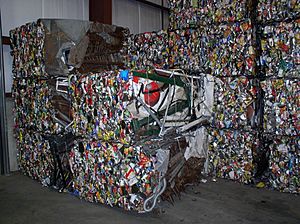Materials Innovation and Recycling Authority facts for kids
The Materials Innovation and Recycling Authority, also known as MIRA, helps cities and towns in Connecticut with recycling and trash disposal. It used to be called the Connecticut Resources Recovery Authority (CRRA) from 1973 to 2014. MIRA is a special type of public agency. It owns a power plant in Hartford that turns trash into energy. MIRA also helps manage other similar plants in Preston, Bridgeport, and Wallingford.
Contents
Recycling Materials for a Better Planet
MIRA's recycling centers sort through mixed trash. They use both machines and people to separate items. This prepares the materials to be used again.
Recycling helps us in many ways. It creates money from old items. More importantly, it saves a lot of energy. Some materials need a lot of energy to make the first time. Recycling them saves even more energy. For example, recycling one ton of aluminum cans saves a huge amount of energy. This is like saving 36 barrels of oil!
Recycling also protects our natural resources. For instance, making one ton of new paper needs about 20 trees. Americans use a lot of paper each year. Recycling paper helps save many trees.
Not everything can be recycled. For the trash that's left, many environmental experts prefer sending it to a trash-to-energy plant. This is better than a landfill. Landfills can cause pollution. They can harm the soil, water, and air. They also create a lot of methane gas.
Turning Trash into Energy
In the United States, most trash (64%) still goes into landfills. About 29% is recycled. Only about 7% is used to make energy. This is different from some European countries. There, recycling and trash-to-energy processing is much higher, around 40-50%.
Trash-to-energy plants work by burning trash. The heat from burning boils water. This creates steam. The steam then spins large machines called turbines. These spinning turbines create electricity. This electricity is then sold to power homes and businesses.
In the early 1990s, new rules were made to keep our air cleaner. These rules caused many trash-burning plants to close. The number of plants in the U.S. dropped from over 1,100 in 1990 to fewer than 90 today. Connecticut has six of these plants. This is because the state decided to reduce landfills. It wanted to find cleaner ways to handle trash.
The Connecticut Resources Recovery Authority (CRRA) was created in 1973. This happened under Governor Thomas J. Meskill. Bridgeport was chosen for CRRA's first trash-to-energy project. Connecticut became the first state in the U.S. without an active city landfill. This happened when a large landfill in Windsor closed in 2015.
Learning About Recycling and Waste
The CRRA used to offer educational programs. These programs were for both kids and adults. They had the CRRA Trash Museum in Hartford. This museum closed in 2016. The programs included visits to schools and tours for scout groups. They also had displays at public events. Teachers could get educational kits to use in their classrooms.
In 2002, CRRA won an award for its great public education efforts. In 2012, CRRA received another award. This was for its new recycling technology and education programs. These efforts helped increase recycling rates in the towns it served.
The Trash Museum: A Place to Learn
The Mid-Connecticut Project Trash Museum opened in 1995. It was a large museum in Hartford, Connecticut. It had exhibits about recycling, turning trash into energy, and landfills. One special exhibit was a sculpture made from old garbage. It was called the "temple of trash." Visitors could also watch live recycling operations on TV screens. The Trash Museum permanently closed its doors in 2016.
The Garbage Museum: Fun with Trash
The Garbage Museum opened in 1993. It had a "Trash-O-Saurus" in the middle of the building. This dinosaur was made from items found in landfills and trash cans. It showed how much trash one person creates in a year.
The museum also had a sky-walk. From here, visitors could watch recycling trucks dump their loads. They could see how glass, plastic, metal, paper, and cardboard were sorted. These items were then crushed or baled. The museum had many hands-on activities. One was a scavenger hunt to find items on the "Trash-O-Saurus." There was also a game show where wrong answers would shower you with recyclables!
The Garbage Museum was funded by money from selling recycled materials. But after 2009, the economy slowed down. Some towns stopped their contracts. The prices for recycled goods also dropped. Because of this, the museum could no longer afford to stay open. It closed in August 2011.
The Garbage Museum was located in Stratford, Connecticut.




